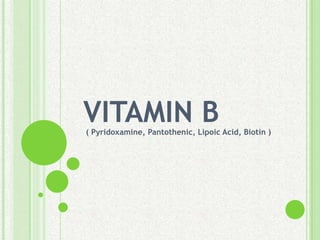Vitamins t uesday report
- 1. VITAMIN B ( Pyridoxamine, Pantothenic, Lipoic Acid, Biotin )
- 2. Vitamin B6 ïpart of the B complex vitamins, the group includes three chemically related substances: pyridoxine, pyridoxal, and pyridoxamine ïWater-soluble vitamin
- 3. FUNCTIONS: ïPyridoxal phosphate is involve in the transaminase reaction ïNeeded for the activity of more than 50 enzymes involved in CHO, protein and fat metabolism ïco-enzyme for many chemical reaction however is related to protein metabolism ïSynthesis of neurotransmitters
- 4. SOURCES âĒGarlic âĒRice bran âĒLiver âĒYeast âĒBanana âĒBroccoli âĒSpinach âĒMeat, fish and poultry âĒSoybean âĒnuts
- 5. Health Effects âĒRheumatoid Arthritis âĒPremenstrual Syndrome (PMS) âĒDepression âĒSkin condition âĒNervous system disorders âĒMuscle spasm
- 6. Vitamin B5 (Pantothenic Acid) ïIs appropriately named, because the Greek word pantothen means âfrom many placesâ. It is fairly stable, but it can be damaged by acids and alkaline.
- 7. FUNCTIONS: ïIt is involved in metabolism of carbohydrates, fats and proteins. It is also essential for the synthesis of the neurotransmitters acetylcholine and of steroid hormones. ïMaintenance of normal growth, healthy skin and integrity of the CNS
- 8. SOURCES ïFound in food especially animal food such as meats, fish, poultry and eggs. It is also found in whole grain and cereal and legumes. In addition, it is thought to be synthesizes by the body. Mushroom, broccoli, cabbage, legumes, salmon and collard green, fish, eggs, nuts, milk
- 9. BENEFITS âĒSynthesizer: acts as a synthesizer of most important components required by human body. âĒStress Buster: has the flair to kill the stress and other serious mental problems like anxiety and depression to ensure fitness of mind.
- 10. âĒCaring Human Heart: holds an impressive record in keeping the human heart in normal working condition. It regulates the level of cholesterol and also helps in controlling blood pressure. âĒSkin and Hair: helps in keeping skin healthy and free from bad appearances. Helps postpone the appearance of early ageing sign over the skin. âĒBuilding Stamina: helps in reducing Body fatigue and weariness and putting the functioning of body parts on right track. âĒImmune system: potent in strengthening the immune system of human body.
- 11. DEFICIENCY âĒInsomnia âĒMuscle cramps âĒTingling sensation of the extremities âĒVomiting
- 12. Vitamin B8 (Lipoic Acid) ïLipoic acid is an enormously important and under-appreciated nutrient whose chemical structure was first discovered in 1951. Our bodies cannot be maximally efficient in producing energy from carbohydrates or fats without the help of lipoic acid. ïAn unusual feature of lipoic acid is its ability to function in a water-based or fat-based environment.
- 13. FUNCTION ïLipoic acid is nestled into one of the most critical spots in all of the body's energy production pathways. ïThe antioxidant function of lipoic acid has been extensively studied, and its ability to help prevent oxygen-based damage to cells is well established.
- 14. SOURCES âĒGreen Plants: The first category includes green plants which have a high concentration of chloroplasts. âĒAnimal Foods: Animal foods constitute the second category of lipoic acid sources.
- 15. Health Effects âĒCataracts âĒChronic fatigue syndrome âĒConditions involving chronic muscle fatigue âĒDiabetes âĒGlaucoma âĒHypoglycemia âĒImpaired glucose tolerance âĒLiver diseases (including alcoholic liver disease) âĒLung cancer
- 16. Vitamin7 (Biotin) ïBiotin, also known as vitamin B7 and vitamin H, is one of the lesser known vitamins of the B complex group. It is one of the most active biological substances, since it has some effect on bacteria and yeast ïBiotin is insoluble in fat solvents and easily soluble in hot water
- 17. FUNCTION ïVitamin B7 or biotin is part of a number of enzyme systems and is required for the metabolism of fats, proteins and carbohydrates. ïBiotin is responsible for a healthy skin and controls the correct distribution of the color pigment.
- 18. SOURCES âĒCereals, pulses and legumes, vegetables, nuts and beef liver contain biotin. Rice bran, rice germ, barley, whole wheat and brown rice are rich sources of biotin. âĒVegetable sources include mushrooms and cauliflower, while walnuts, peanuts, peanut butter and almonds also contain this vitamin.
- 19. BENEFITS âĒUsed to control and reduce hair loss resulting from male alopecia. âĒEssential for proper functioning of the enzyme systems and metabolism



















